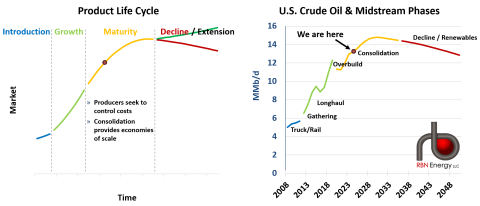Since the advent of the Shale Revolution, the U.S. has experienced a massive surge in oil, gas and NGL production — creating a bonanza of opportunities. But the attitudes of energy companies, owners and investors have shifted from “drill-baby-drill” to a focus on returning value to shareholders. It’s an evolution reminiscent of the economic concept known as the product life cycle. And that got us thinking. In today’s RBN blog, we’ll discuss the introduction, growth and maturity phases of the Shale Revolution, assess where we are today, and explore a couple of potential paths forward.
The product life cycle is a concept in economics that broadly describes the phases that new products often experience from the time that they come to market until their eventual decline. It’s an evolution we can liken to the run-up and subsequent tapering of domestic crude oil production (see Figure 1 below). Before we get started, we should acknowledge that we’re not perfectly analogous here because oil and gas supply curves are dictated by producer economics and the rate at which new wells replace older declining wells. However, while it’s not an exact corollary — a commodity is not a product type in the sense that a smartphone is — we think it will be instructive to view unconventional drilling through the lens of a technology-based product play.
We should also note that our analogy includes unconventional production as well as the midstream and downstream sectors that have been directly impacted. In an industry as pervasive and well developed as energy, vertical sectors are mutually dependent. For example, new production growth is contingent on midstream facilities while they, in turn, are anchored on production and throughput expectations. Likewise, downstream facilities, like refineries, rely on midstreamers’ efficient delivery systems.
Further, although the product life cycle has gained widespread recognition as a useful framework as companies strategize ways to market and sell products, there is no universally agreed-upon standard of phases, as they have been redefined over time. For this blog, we will consider four stages: Introduction, Growth, Maturity and Decline/Extension.
Figure 1. The Product Life Cycle Compared to U.S. Crude Market Phases. Source: RBN
Join Backstage Pass to Read Full Article









